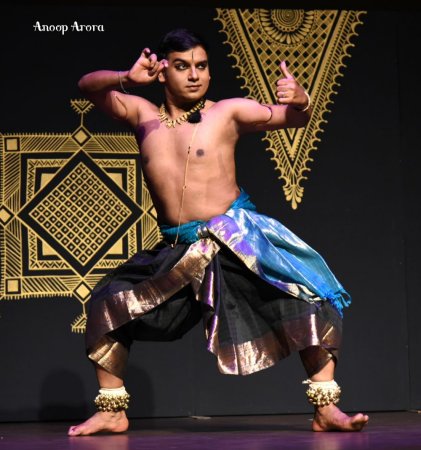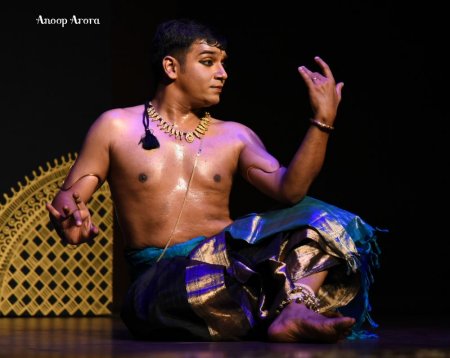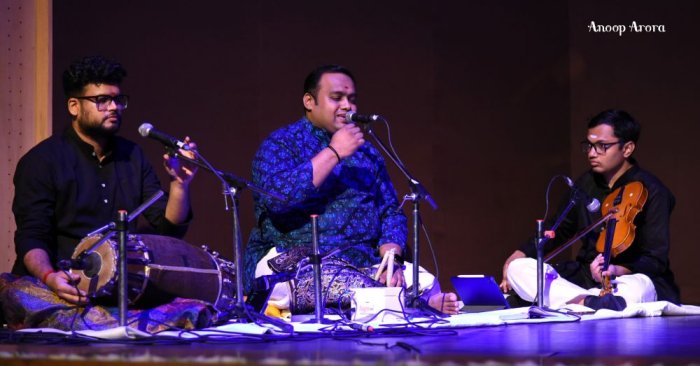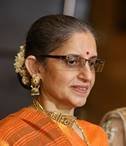
|   |

|   |
Dr. Himanshu Srivastava dazzles in portrayal of three Kalidasa nayaks - Shveta Arora e-mail: arorashveta1806@gmail.com Photos: Anoop Arora May 15, 2025 It is not often that a piece of literature or art that is romantic, in dance or in theatre, explores the internalities of the nayak (hero). It is always the heroine who is talked about - her physical beauty, her lovable mannerisms, her upheaval of emotions at falling in love, how it relates with nature and the environs and the dramatics associated with it. All that is practically absent for the male counterpart. His looks are hardly ever talked about, and if they are, it is mostly about his muscles, strength and valour. Beauty is not a word used for him, and his emotions are hardly ever depicted. It was only in a video performance in Odissi by Rudraprasad Swain that I saw the nayak craving for his beloved in the monsoon. Maybe it is not considered masculine in art to give vent to such emotions, or maybe the emotional quotient is less attractive in the nayak's case.  Himanshu Srivastava On 4 April 2025, at the Jawahar Bhawan in Delhi, Dr. Himanshu Srivastava debuted a Bharatanatyam performance titled 'Madly in Love: Heroes of Kalidasa' accompanied by Sujesh Menon on vocals, Sriram Vignesh on violin and Prajesh Nair on mridangam.. This recital by a male dancer about nayaks was full of love, longing, despair, tenderness and hope, and was performed so evocatively that Himanshu moved, charmed, seduced and dazzled the audience effortlessly. The background screen was black, with geometrical, golden motifs in folk art styles. Sujesh Menon began with a stuti to Devi Saraswati in raga Saraswati, 'Manikya veena', which was sung melodiously. Himanshu introduced this new presentation, explaining that Kalidasa's works have been known for their use of metaphors and interpretation of human emotions. Kalidasa's plays are wonderful works of literature and have prompted a lot of research and analysis, not only of their depictions of nature, the heroines, yakshinis and queens, but also of their heroes. The first hero he spoke about was Kamadeva or Manmatha, known in many parts of the world by many names. He spares none when it comes to using his arrows, not even Shiva. It is during the spring that he comes to rage within all, he shoots a pining for love. He has a dark body, sharp features and an attractive gait. His weapon is his honeyed bow, with which he shoots five kinds of flowered arrows while riding his steed, the parrot. The five flowers are mallika, ashok, aamramanjari, white lotus and blue lotus, in increasing order of potency. He comes with a swagger, accompanied by his minister, vasant. The composition 'Madanotsavam', verses from Kumarasambhavam, was in raag Hamir Kalyani, taal roopakam, composed by Dr. Sridhar Vasudevan. Himanshu made a dazzling entry as Kamadeva from behind the screen wearing a black sari as a dhoti and a blue kati vastram. He wore a golden neckpiece, a golden janeyu and u-shaped armbands. Himanshu's entry was vigorous and assertive, depicting the bow in one hand and the various flowers in the other, one corner of his lips upturned in a confident smile. Kamadeva arrives on his steed the parrot, shown by a horizontal leg lift going backwards. Then Manmatha goes around selecting the flowers. He dusts the pollen from them and shoots them as arrows. Each flower is shot in a different manner. Some are rotated and then shot, spreading the potion all around the atmosphere. He goes to the pond and selects the lotuses; the best ones adorn his ears. Injured hearts pine in love and infatuation. And then followed the panchbaan and their shooting in broad plie, moving in expansive stances. Manmatha was incarnate on stage.  Himanshu Srivastava The next and central piece was a varnam in which the nayak is pining for his separated love. This is from Kalidasa's 'Meghadootam'. The composition was in ragamalika, talamalika, and was composed by Rohit Bhatt Uppoor. The nayak has been exiled for seven months by the king because he was busy flirting with his beloved and brought the flowers for his master's puja late. In the season of ashad, as he looks at the mountains, he sees clouds travelling towards his home town Alkapuri. "Payodhare," he addresses them, and requests them to take his message to his beloved as quickly as possible. He is desperate and bursts out to them. He tells them how to recognize his beloved. She will be the only one counting the days of separation till his return. She will have given up eating and like a fish, which overturns when it dies in water, she would be drowning in the sea of her own tears. She would not have the strength to walk, he says, depicting her dragging her feet and then falling... That's what the nayika would look like. He gives the clouds some flowers to take away with them and shower her with. He can feel the droplets from the clouds on his hands and face. Himanshu began by showing the clouds in expansive moves, and incorporated the depictions of grey nimbus clouds, rain and lightning into energetic jathis throughout the varnam. The dozens of different hastas and jathis he used to show the rain and clouds spoke of his mastery and inventiveness. The droplets fall on the nayak's body and sizzle. "Payodhare," he addresses the clouds, "in Alkapuri my beloved sits in grief." The sun rises and then sets each day, the blossoms bloom and close each night, and thus she tracks the passage of each day as she waits and counts the days to his return. She draws lines to mark the number of days. She removes her ornaments and then, in anticipation, wears them again. The nayak tells the clouds that they should not move slowly as he hands his patrika to them. "Don't move like a snail or roam like an elephant. Instead, move like a deer that romps. Do not meander slowly through the tall mountains you encounter on the way." He shows them the path and direction to follow to zip through the valleys. "When it rains on the mountain tops, do not lounge and stop for a rest." Himanshu depicted all this so evocatively that one could almost see the clouds being tempted to rest on the way! Guiding the clouds further, the nayak says that in his city, there will be other houses, tall and impressive, with beautiful streets covered with fragrant petals. Himanshu depicted the nayak's pride in Alkapuri as he praised his home. "My home will be fairly large," Himanshu portrayed the nayak saying proudly, "with vines, trees and flowers, carved doors and windows, and a pond with lotuses. My beloved will get her veena, but she has forgotten the notes." Here, the violinist beautifully played the discordant notes being played by the despondent nayika as depicted by the nayak! She will draw a kolam, only to wipe it off, the nayak further depicts. She sits down to draw his face on a piece of bark, taking the black from her kajal and red from her lips. She brings it close to her face and kisses it. "Your droplets should fall on her face and on her lips. Oh clouds," he exhorts them, "do not go elsewhere - pratyadesh." In the last scene, Himanshu depicted the clouds changing their direction and the nayak telling them to head straight and fast to his city. It was a very intricately enacted varnam, with Himanshu using his prowess in bhava and his eyes to portray the anguish of the nayak.  The orchestra That was one part of the piece. Besides that, Himanshu displayed his mastery over rhythm and his stamina in the plethora of jathis he used. They were expansive, with well-defined hastas and rhythmic footwork, featuring the use of leaps, leg lifts, horizontally lifting the leg to rotate it, leg stretches sideways and backward. The entire stage was covered in jathis that spanned left to right, forward and backward, diagonally across. Himanshu moved from one end of the stage to the back and then to the other end, moving on tiptoe and then backward in leaps. Though he was portraying a nayak in viraha, who is patriarchal in his assumption that his nayika is faithfully waiting for him, he gently smiled and moved with the effortless agility of a gazelle all over the stage. Sujesh Menon wove sheer magic (he was also filling in for the nattuvanar). Along with Sriram Vignesh on violin and Prajesh Nair on mridangam, he created a mesmerizing piece of the varnam. In the last piece, Himanshu presented a totally different style, a slower, seated, tender abhinaya presentation that engrossed, amused and delighted the viewer. He portrayed the king Agnimitra from Kalidasa's Malavikagnimitram. The composition was in ragamalika, talamalika, and had been composed by Sujesh Menon. The king is blessed with two loving wives when he chooses to romance the dasi of one of his queens. Malavika is a beautiful, accomplished dancer whose skill and personality gives the king great joy and fills his heart. He organizes a sabha with both the queens seated beside him, and Himanshu's piece was about how he expresses his feelings about her dance and her, and even has a secret exchange with her, despite the presence of his queens and his entire court. Himanshu chose a table as a prop to sit on, which was placed in front of the screen. He depicted the king seeing a portrait of his family and noticing the beautiful maiden standing behind his queen. She walks into the sabha in a ghunghat, holding her sari with one hand. As she dances, he finds himself lost in thoughts of her. His heart flutters and he imagines holding her close to him. But he has to disguise his feelings since he sits flanked by his two wives. He cannot stop admiring her physical beauty. Himanshu's hold on abhinaya is wonderful. He showed the king's heart fluttering as Malavika dances. He keeps wiping the sweat on his brow from the nervousness of his queens watching him admiring the dasi. Her eyes are like arrows and the arrows strike him in his heart. He dreams of embracing her. But when he forgets himself and expressed this in gestures, he disguises it by feigning swatting a fly or showering her with coins. After performing most of the piece seated on the table, Himanshu got up to show the final steps. She pulls her ghunghat over her head again and walks away bowing. But before leaving, she covertly drops a piece of cloth behind, which the king quietly picks up, smells tenderly and hides it. In return, he nonchalantly throws his ring away and she comes back to pick it up. This is the confirmation of their infatuation with each other and the beginning of his love for her. Himanshu's face portrayed the entire romantic episode beautifully. There was not a minute in which the viewer lost interest during the entire recital - that was the power of his performance. The nritta was so powerful that your eyes would follow him all over the stage, and the abhinaya in portraying three different characters was effortless. A befitting round of applause followed.  Shveta Arora is a dance-mad writer who chronicles classical dance events in Delhi (and also those online). In 2009, she started the blog Kala Upasana at delhiculturecomment.blogspot.com, where she began posting her own writing along with photographs clicked by Anoop Arora, her husband. She's been dancing all her life as a devotee, but resumed her formal training in Kathak in her 50s and has passed her fifth year Kathak exams. |